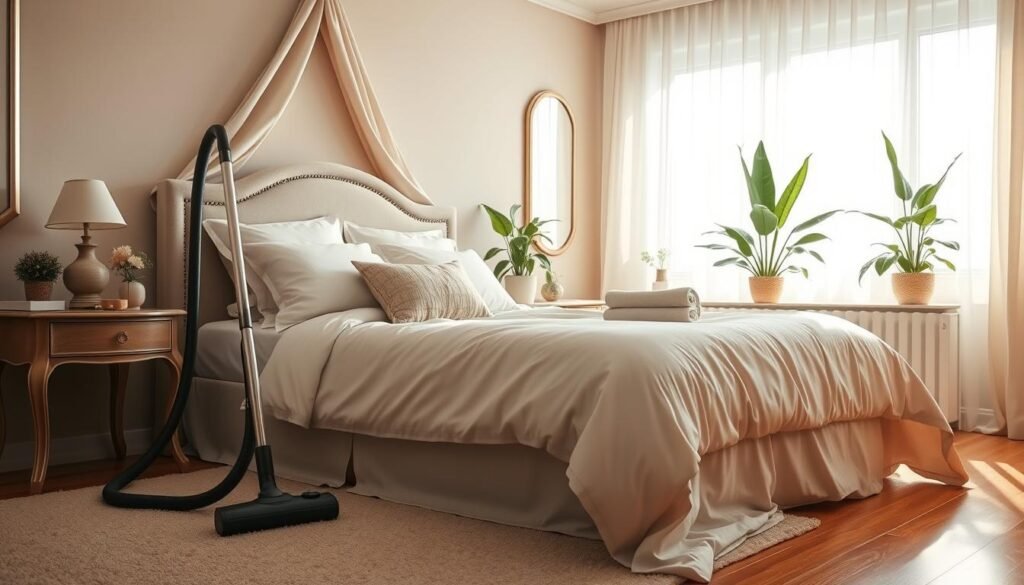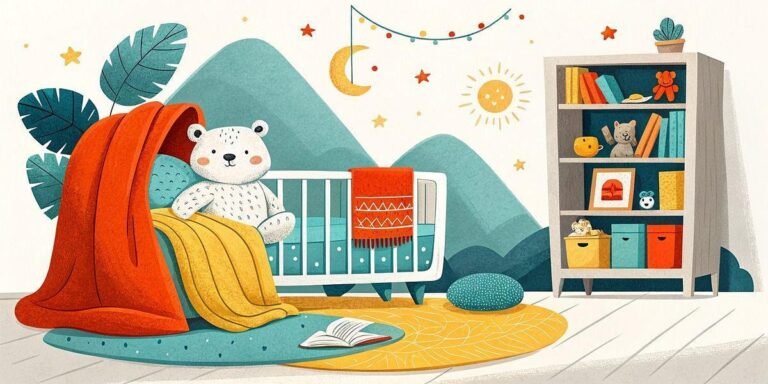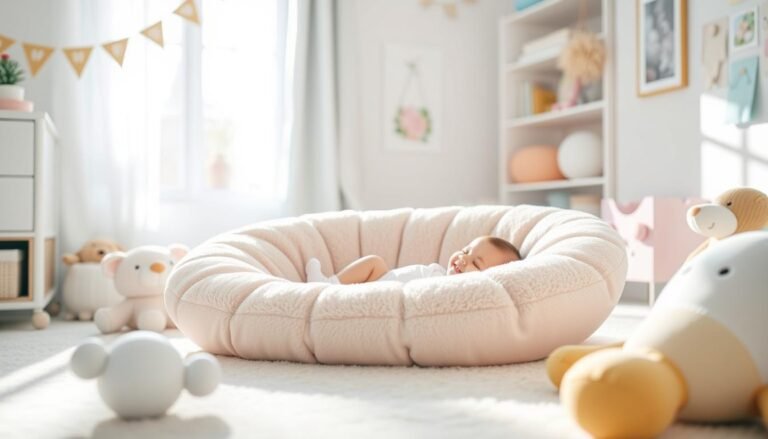Baby Bed Bugs: What You Need to Know

As a parent, I often wonder how to keep my baby safe from tiny creatures in their bed. Baby bed bugs are common in many homes. It’s important to know how to spot and get rid of them.
It’s key to understanding baby bed bugs’ life cycle and how they look. They start small, about 1.5 mm, and grow by 0.5 mm with each stage. Knowing how they develop and behave is crucial to getting rid of them.
Key Takeaways
- Baby bed bugs are a sign of a potential bed bug invasion and should be eliminated promptly to prevent further infestation.
- Infant bed bug infestation can be prevented by regular vacuuming and washing bed linens in hot water.
- Baby bed bugs are known to bite more frequently than adults, causing severe allergic reactions in some individuals.
- Professional pest control services can effectively kill bed bugs by maintaining room temperatures between 140 degrees F for 2-3 hours.
- Regular inspection and follow-up extermination visits are crucial to preventing re-infestation.
- Understanding the life cycle and physical characteristics of baby bed bugs is essential to tackling the issue and getting rid of baby bed bugs.
Understanding Baby Bed Bugs and Their Life Cycle
As a parent, knowing about the baby bed bug life cycle is key to getting rid of them. Baby bed bugs, or nymphs, go through five stages before becoming adults. They are clear, light-colored, and flat, with an oval shape.
The baby bed bug growth stages are important to grasp. Here’s a quick overview:
- Egg stage: lasts between 6 to 10 days
- Nymph stage: has five instars, needing a blood meal to molt
- Adult stage: takes about 10 weeks to mature
It’s also crucial to know about baby bed bug feeding patterns. They need blood to live and can feed every 3-7 days. Female bed bugs lay 5-20 eggs after feeding, with an average of ~113 eggs.
By understanding the baby bed bug life cycle, baby bed bug growth stages, and baby bed bug feeding patterns, you can prevent and get rid of them from your home.
| Stage | Duration | Description |
|---|---|---|
| Egg | 6-10 days | Female bed bugs lay eggs in cracks and crevices |
| Nymph | 5 instars | Baby bed bugs go through five stages of development before reaching adulthood |
| Adult | 10 weeks | Bed bugs reach full maturity and can reproduce |
Why Your Baby’s Room Might Be Attractive to Bed Bugs
As a parent, it’s key to know why bed bugs might be drawn to your baby’s room. Food, warmth, and humidity make it a perfect spot for them. If not dealt with, a small problem can quickly turn into a big infestation.
Several things can attract bed bugs to your baby’s room, including:
- Clutter and mess, which provide hiding spots for bed bugs
- Used furniture, especially if it’s been bought second-hand
- Poor hygiene and lack of regular cleaning
- The high density of people in the room, increases the likelihood of bed bug transfer
To avoid bed bug infestations, keep your baby’s room clean and clutter-free. Regular vacuuming and cleaning, along with mattress encasement covers, can help. Being proactive can reduce the chance of bed bugs in your baby’s room.
The National Pest Management Association (NPMA) says about 20% of people have seen bed bugs at home or in hotels. This shows how important it is to stay alert and take steps to protect your baby’s room from bed bugs.
| Preventive Measures | Benefits |
|---|---|
| Regular vacuuming and cleaning | Reduces clutter and hiding spots for bed bugs |
| Protecting mattresses with encasement covers | Prevents bed bugs from accessing the mattress |
| Minimizing debris and clutter | Decreases the likelihood of bed bug infestations |
By taking these steps and being aware of what attracts bed bugs, you can keep your baby’s room safe. This way, you can avoid a big problem and keep your nursery bed bug-free.
Signs of Baby Bed Bugs in Your Nursery
As a parent, knowing the signs of baby bed bugs is key. These pests can upset your baby’s comfort and health. Look for red, itchy welts on your baby’s skin, often in groups or lines.
Also, watch for small bloodstains on sheets and a sweet, musty smell. Regular checks of your nursery are important. Look closely at common hidden spots where bed bugs might hide.
- Behind wallpaper and molding
- Inside crib mattresses and box springs
- Underneath carpeting and rugs
Being alert to these signs helps protect your baby. It ensures their health and happiness.
| Signs of Baby Bed Bugs | Description |
|---|---|
| Red, itchy welts | Clusters or lines of bites on the skin |
| Small bloodstains | On sheets and other fabrics |
| Sweet, musty odor | Noticeable in the air |
How Baby Bed Bug Bites Affect Infants
As a parent, knowing how baby bed bug bites affect infants is key. These bites can make the skin itchy, swell, and turn red. They might look like other skin issues. If you think your baby has been bitten, getting medical help is vital to check for other causes.
Bed bug bites can upset and distress your baby. Newborn bed bug treatment often means washing the area with warm, soapy water. Anti-itch creams are also used. Sometimes, stronger creams are needed for really bad itching.
Knowing the signs of infant bed bug infestation is crucial. Look for small, raised, and red dots with darker centers. These bites often show up in lines or clusters. Spotting these signs early helps you act fast and keep your baby comfortable.
To stop baby bed bug bites, getting rid of bed bugs at home is essential. Wash all bedding in hot water and dry it on high heat. Also, call a licensed pest control service to check and treat your home.
| Signs of Bed Bug Bites | Description |
|---|---|
| Small, raised, and red dots | These bites can appear in a line or cluster together |
| Itchy skin | Can be accompanied by swelling and redness |
| Redness and swelling | Can be mistaken for other skin conditions |
Preventing Bed Bugs in Your Baby’s Room
As a parent, it’s crucial to prevent bed bugs in your baby’s room. Regular checks can spot problems early. By following baby bed bug prevention tips, you can lower the risk of an infestation.
Effective ways to control pests in your baby’s room include using mattress encasements and reducing clutter. Sealing cracks also helps keep bed bugs out. Washing your baby’s bedding and clothes in hot water can kill any bugs.
- Regularly vacuum and inspect the room for signs of bed bugs
- Use a bed bug-proof mattress cover
- Keep the room clean and clutter-free
By following these tips and staying alert, you can ensure a bed bug-free space for your baby.
| Prevention Strategy | Effectiveness |
|---|---|
| Regular Inspections | High |
| Mattress Encasements | High |
| Reducing Clutter | Medium |
Safe Treatment Options for Nursery Infestations

When treating baby bed bug infestations, safety and effectiveness are key. Newborn bed bug treatment must focus on the baby’s health. Heat treatment is a good option. It uses special equipment to kill bed bugs and their eggs with heat.
Insecticide sprays can also be used. But, it’s important to pick a spray that’s safe for babies. Always follow the instructions. Infant bed bug infestation treatment needs careful handling and professional advice when possible.
Regular vacuuming and washing bedding in hot water are also helpful. For baby bed bug treatment, being thorough and consistent is crucial. These steps can make a baby’s sleep area safe and bed bug-free.
- Using a mattress encasement to prevent bed bugs from infesting the mattress
- Washing and drying bedding and clothing in hot water and high-heat
- Vacuuming regularly, especially around the crib and changing table
By being proactive and informed, parents can protect their baby’s health. This is crucial for infant bed bug infestation treatment.
| Treatment Option | Description |
|---|---|
| Heat Treatment | Uses specialized equipment to heat a room to a temperature lethal to bed bugs and their eggs |
| Insecticide Sprays | Targets areas where bed bugs are present, but must be used with caution and follow manufacturer’s instructions |
| Regular Vacuuming and Washing | Helps control bed bug infestations by removing bed bugs and their eggs from the environment |
Natural and Chemical-Free Control Methods
As a parent, you want to keep your baby safe from harm. This includes protecting them from bed bugs. Natural baby bed bug control methods are safe for your baby and the environment. They’re a better choice than traditional pest control, which can harm your baby’s health.
Effective natural methods include heat treatment and diatomaceous earth. Heat treatment uses a device to heat a room to 120°F to kill bed bugs. Diatomaceous earth is a powder that dehydrates and kills bed bugs. Preventing bed bugs is also important. This can be done by regularly inspecting your baby’s room and using bed bug-proof mattress encasements.
Here are some tips for natural baby bed bug control:
- Wash and dry bedding regularly
- Use a mattress encasement
- Vacuum regularly, around beds and furniture
- Use a dehumidifier to reduce moisture
By following these tips and using natural methods, you can keep your baby safe from bed bugs. Remember, prevention is key. Regularly inspect your baby’s room for signs of bed bugs. With the right natural methods, you can keep your baby’s room bed bug-free and ensure a healthy sleep environment.
| Method | Description |
|---|---|
| Heat Treatment | Kills bed bugs and their eggs through high temperatures |
| Diatomaceous Earth | A natural powder that dehydrates and kills bed bugs |
| Bed Bug-Proof Mattress Encasements | Prevents bed bugs from infesting mattresses |
When to Call Professional Pest Control
As a parent, dealing with a baby bed bug infestation can be overwhelming. It’s hard to know if you should handle it yourself or call professionals. If the problem is severe or keeps coming back, it’s best to get professional baby bed bug control services. These experts can offer effective baby bed bug extermination and baby bed bug treatment to make sure your baby’s room is free from bed bugs.
Some signs you might need professional help include:
- Large numbers of bed bugs or eggs in your baby’s room
- Persistent infestations despite DIY efforts
- Severe bite reactions or allergic responses in your baby
A professional baby bed bug control service will do a detailed inspection. They’ll create a special baby bed bug treatment plan to get rid of the bugs. They might use heat treatment, seal cracks, and use targeted baby bed bug extermination methods to keep your baby’s room safe and bug-free.
It’s always safer to be cautious when it comes to your baby’s health and safety. If you’re not sure how to deal with bed bugs, don’t hesitate to get professional baby bed bug control services. They offer effective and lasting solutions.
Creating a Bed Bug-Free Sleep Environment

To make sure your baby sleeps well, you need to keep their sleep area free from bed bugs. This means choosing the right bedding, protecting furniture, and using good monitoring systems. A solid plan to keep pests away is key.
A bed bug-free sleep area is not just comfy; it’s also safe and healthy. Bed bugs can make sleeping hard, cause discomfort, and lead to allergies. So, keeping your baby’s sleep space clean is very important.
Bedding Choices and Care
Start by picking the right bedding. Look for materials that resist bed bugs, like tightly woven covers. Also, wash and dry bedding in hot water to kill bugs and their eggs.
Furniture Protection Tips
Keeping furniture safe is also crucial. Don’t let clutter build up in your baby’s sleep area. Bed bugs can hide in messy places. Use encasements and try diatomaceous earth or baking soda to kill bugs.
Monitoring Systems
It’s important to watch for bed bugs regularly. Use interceptors or active monitors to catch infestations early. By following these steps, you can keep your baby’s sleep area safe and bug-free.
Long-Term Prevention Strategies
As a parent, it’s vital to use long-term baby bed bug prevention strategies. This keeps your child’s room free from bed bugs. Regular checks help spot problems early. Keeping things clean and using preventive steps can lower bed bug risks.
Effective baby bed bug control includes sealing gaps, washing bedding often, and using mattress covers. Also, check second-hand items before bringing them home. Be careful with items that might have come into contact with bed bugs.
Good baby room pest management mixes nonchemical ways like heat treatment and sealing gaps. Working with your family and caregivers helps make a strong plan. Remember, stopping bed bugs before they start is the best way to keep your baby’s room safe.
Here are some important tips for long-term baby bed bug prevention:
- Regularly inspect your baby’s room for signs of bed bugs
- Keep the room clean and free of clutter
- Use preventive steps like mattress covers and bed bug-proof bedding
Recovery and Ongoing Monitoring Plans
After treating a baby bed bug infestation, it’s crucial to focus on baby bed bug recovery and ongoing monitoring. This helps prevent re-infestation. Regular inspections and maintenance are key to keeping the environment bed bug-free.
Inspecting for warning signs is a vital part of baby bed bug prevention maintenance. Look for small, red-brown spots or bloodstains on sheets and mattresses. Also, check for live bed bugs in cracks and crevices, around sleeping areas.
To keep your home bed bug-free, consider these tips:
- Wash and dry bedding regularly
- Vacuum mattresses and carpets often
- Inspect second-hand items before bringing them home
Remember, ongoing monitoring is essential to prevent re-infestation. By staying vigilant and proactive, you can ensure your baby’s sleep environment remains safe and bed bug-free.
Conclusion: Keeping Your Baby Safe from Bed Bugs
Keeping a baby bedbug-free environment is key for my child’s health. Regular checks of the nursery and using preventive measures help a lot. If bed bugs show up, we deal with them fast to keep our baby safe.
Being careful and using the right effective treatment options and bed bug prevention strategies is important. This way, my baby can have a safe and comfy place to sleep and grow.
Now, I know how to protect my baby from bed bug dangers. I’m ready to keep their sleep area a safe haven. It’s a big job, but it’s essential for my baby’s health and happiness.
FAQ
What are the physical characteristics of baby bed bugs?
Baby bed bugs, or nymphs, are small and oval-shaped. They are usually translucent or pale. They are about the size of a poppy seed and hard to see without a magnifying glass.
How do baby bed bugs develop and grow?
Baby bed bugs grow by shedding their skin several times. They start as tiny nymphs and grow into adult bed bugs. Adult bed bugs can be up to 1/4 inch long.
What attracts baby bed bugs to a baby’s room?
Baby bed bugs are drawn to warmth, humidity, and food sources in the nursery. They like cluttered, dark places with lots of hiding spots.
What are the signs of a baby bed bug infestation?
Signs include small blood spots on bedding and shed skin. You might see bugs in cracks and red, itchy bites on your baby’s skin.
How can baby bed bug bites affect infants?
Bites can cause itchy, red welts on an infant’s skin. Excessive scratching can lead to skin infections. Seek medical help if you think your baby has been bitten.
How can I prevent bed bugs in my baby’s room?
Keep the room clean and clutter-free. Regularly check for bugs and use protective covers for the crib and mattress. Be quick to act if you suspect bed bugs.
What are some safe treatment options for nursery infestations?
Safe treatments include heat treatment, targeted sprays, and thorough vacuuming. Choose methods that are safe for your baby and the environment.
When should I call a professional pest control service?
Call a professional if the infestation is severe or DIY methods fail. They have the tools and knowledge to safely remove bed bugs from your baby’s room.
How can I create a bed bug-free sleep environment for my baby?
Choose easy-to-clean bedding and furniture. Use protective covers for the crib and mattress. Regularly check for signs of bed bugs.
What are some long-term prevention strategies for baby bed bugs?
Long-term prevention includes regular checks, keeping the room clean, and using proactive measures. Use encasements and monitoring systems to catch and eliminate bed bugs early.




